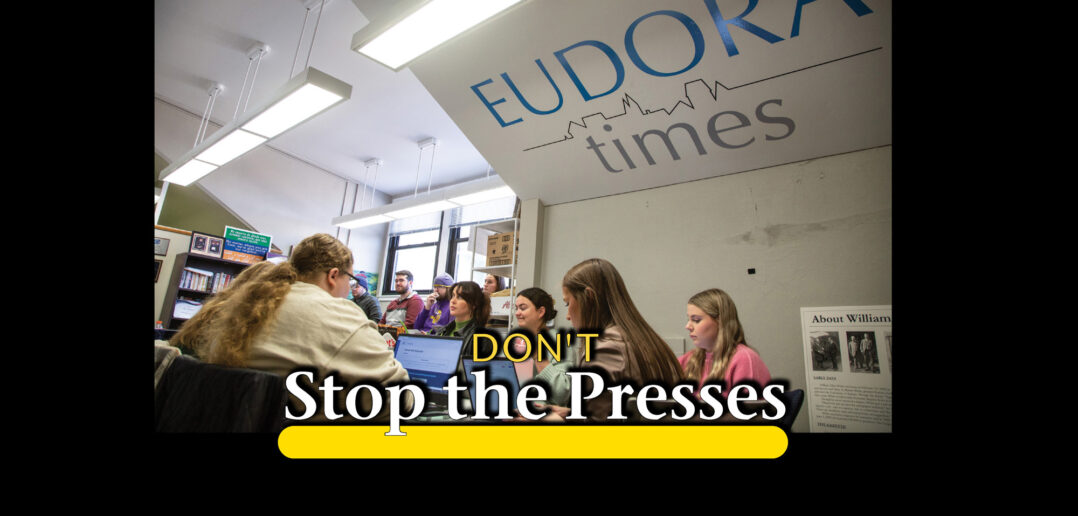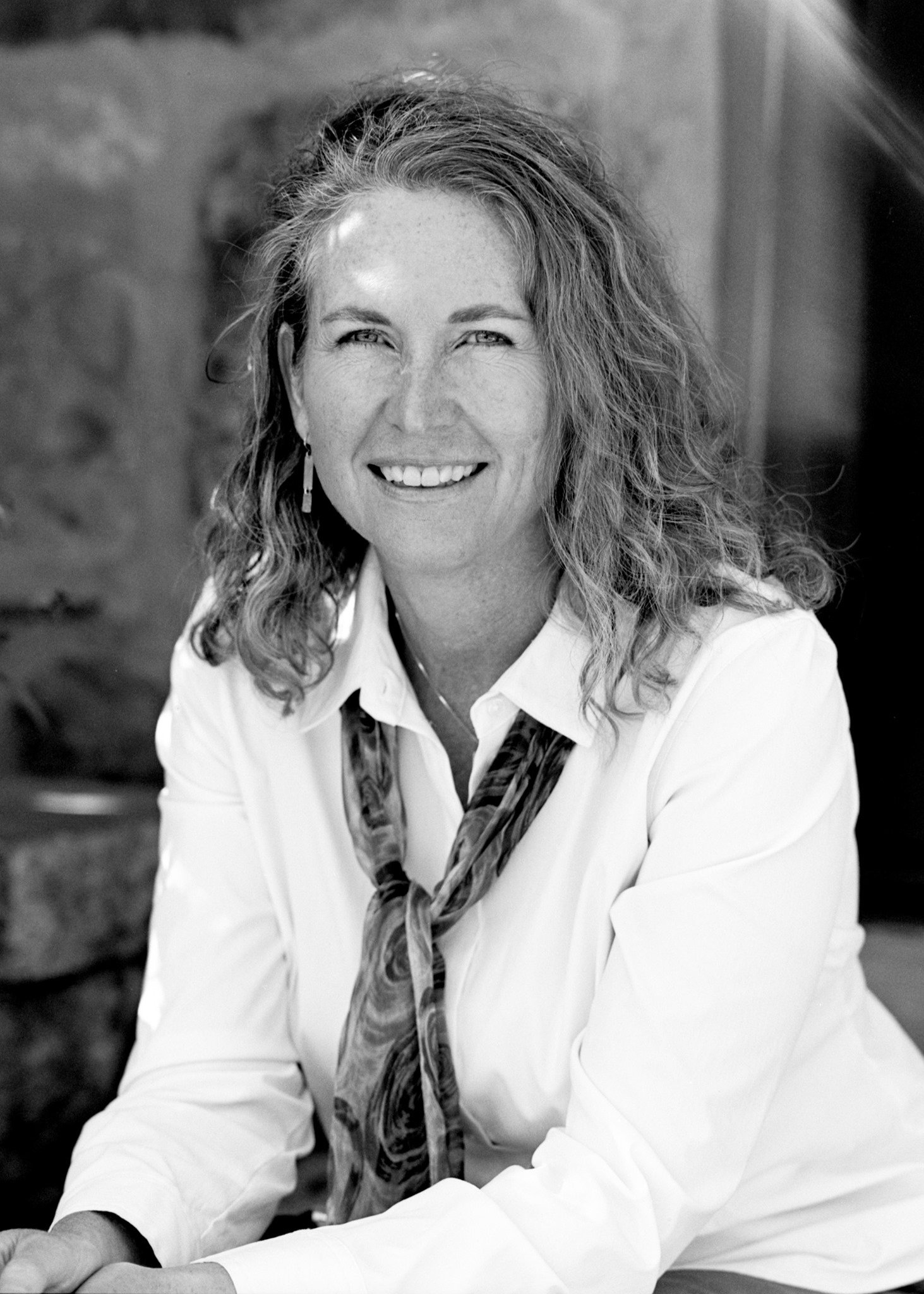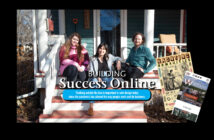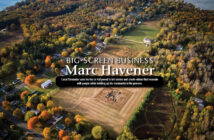| story by | |
| photo by | Steven Hertzog |
| OPEN A PDF OF THE ARTICLE |
The theme “learning by doing” is key within KU’s School of Journalism, which prepares its students for today’s ever-evolving media marketplace.
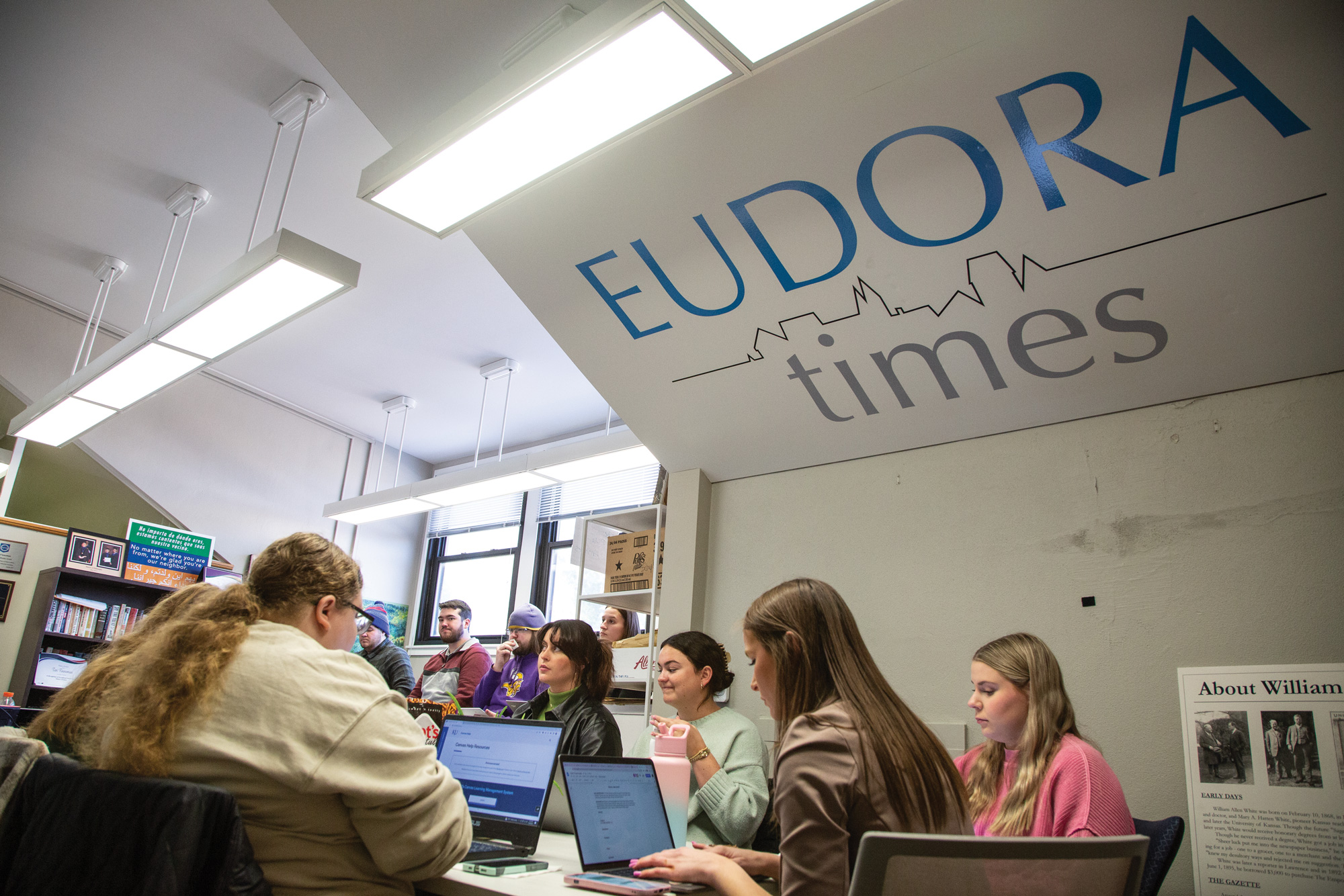
KU students who publish The Eudora Times in a staff meeting
The Eudora Times reads just like a small-town newspaper should, with stories about the search for a new city manager, school board decisions and the middle school spelling bee. Reporters attend meetings and events, interview city leaders and residents, write articles and take photos. None are paid, though—University of Kansas (KU) students and faculty comprise the entire staff.
“The best experience my students can get is actually doing it and having the experience of being a reporter,” says Teri Finneman, an associate professor and journalism historian at KU’s William Allen White School of Journalism and Mass Communications, who launched the online newspaper in 2019 and serves as publisher. “They’re going to learn way more than from me just telling them how to be a reporter.”
That theme—learning by doing—runs deep in KU’s J-school and prepares students to succeed in today’s ever-evolving media marketplace. In addition to The Eudora Times, students contribute to The University Daily Kansan, produce programming for KUJH-TV and Media Crossroads, and craft marketing campaigns at The Agency and Steam Whistle Creative. All teach journalism and mass communications majors essential research, writing, problem-solving and critical-thinking skills while helping them connect with audiences, says Ann Brill, the J-school’s dean.
“Those pillars of journalism have not changed,” Brill says.
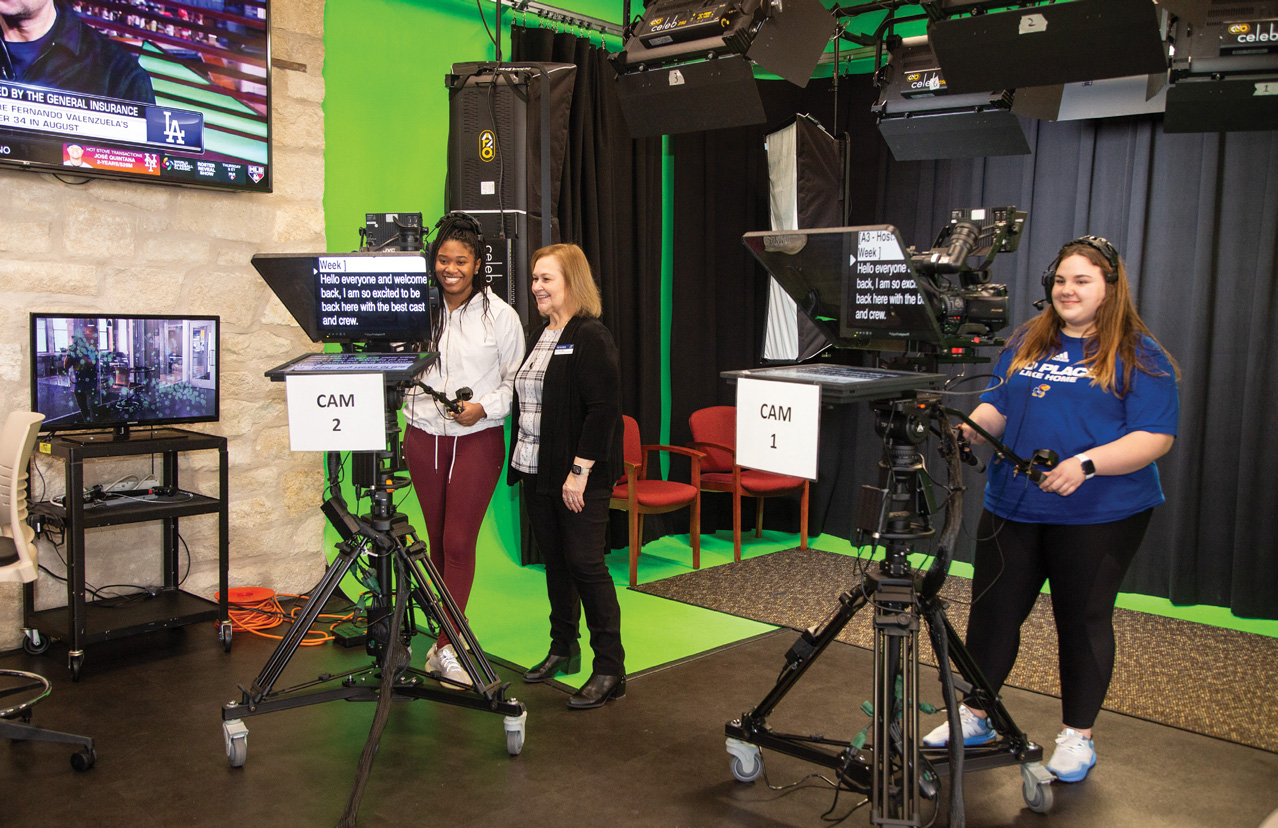
Dean of the KU Journalism School Ann Brill, with two students in the TV studio
Training for the Future
KU has been training journalists since 1891, when it offered its first course in the subject, and journalism classes have been taught continuously since 1903. The Kansas Board of Regents established what was initially known as the William Allen White School of Journalism and Public Information after the Pulitzer Prize-winning editor of The Emporia Gazette died in 1944. It was among the first such schools to be nationally accredited in 1948.
KU’s J-school now offers three bachelor’s degree concentrations: multimedia journalism; digital marketing communications, advertising and public relations; and media arts and production. A fourth concentration, sports media and society, will be offered beginning in fall 2023.
LOCAL MATTERS
Our Local Advertisers – Making a Positive Impact
The programs are housed at Stauffer-Flint Hall, which, in 2019, completed a $5-million renovation. A state-of-the-art broadcast and videography studio, and open-concept classroom dominate the ground floor, and facilities were updated throughout the building. There’s a digital instruction space for students; they can also check out cameras and equipment, get writing and editing assistance, tap career resources and access additional services.
The J-school’s core curriculum requires classes like writing and media literacy, as well as data and statistics, audio and video production and editing, graphic design, image editing, web coding and more before students move on to higher-level courses within each concentration. Throughout it all, students focus on creating interactive media experiences and interfacing with increasingly fragmented audiences.
“If you are a left-handed bowler, there’s a website for you. There’s something for everyone now,” Brill explains. “How do you prepare people for that in the big sense? We’re constantly helping students understand why it’s so important in society that we be the storytellers.”
Real World, Real Material
Those stories can take myriad forms, and multimedia journalism graduates find jobs doing everything from writing and editing to blogging, podcasting, producing video and websites, and managing social media content for traditional news outlets and publications, nonprofit organizations, sports teams, digital media companies, health-care systems and more. The best way to ready students to meet those challenges, Finneman says, is to take them on while still at KU.
“I very much want my students to be working in the real world and producing real material, not just homework for a class,” she adds.
That proved more challenging than Finneman expected when she began teaching at KU. She’d hoped to find a small-town newspaper her students could write for and was surprised Eudora didn’t have one. So students in her social media class instead provided content for the Eudora Convention and Visitors Bureau. Then, Finneman created The Eudora Times so there would be a home for feature articles, such as one about the opening of Zeb’s Coffeehouse.
“It was essentially kind of an after-school club at KU” that she and two students for the first two years ran in their spare time, she explains.
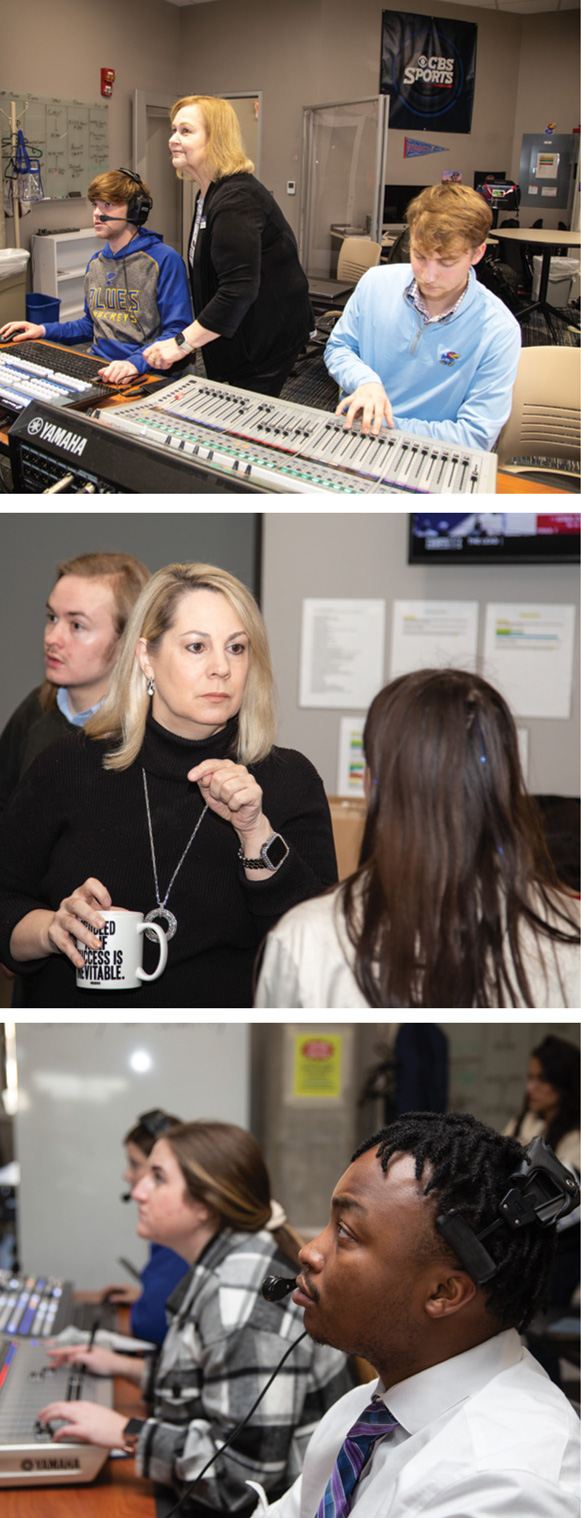
top to bottom: Dean Brill in the TV production room watching students produce the KUJH News, Professor Melissa Greene-Blye works with students producing the KUJH News, KU students maintain their focus during a live news broadcast
The Eudora Times currently has a staff of about 15, mostly from Finneman’s advanced reporting and community journalism classes. They cover everything from county commission meetings to senior activities throughout the school year; the paper goes on hiatus during academic breaks and the summer. It’s all online (except for two special issues that were printed) and financed entirely by donations to the KU Endowment, which provides small scholarships to offset students’ expenses.
Budding journalists garner experience. Eudora benefits from again having a newspaper. Finneman’s vision is greater than that, though: She hopes the paper will help combat the rise of news deserts, or areas where local news coverage is largely absent. More than one-quarter of U.S. newspapers have closed since 2005, and that figure is expected to reach one-third by 2025, according to a report released by Northwestern University last year. The problem is most acute in rural regions, says Finneman, who has collected oral histories from aging newspaper publishers throughout the Great Plains.
Communities become isolated when a newspaper closes, and fewer newspapers means fewer jobs. Publishing The Eudora Times opens students’ eyes to the satisfaction and importance of community journalism, she adds.
Some of her students have “changed the direction of what their interests were because of their experience,” she says. “That’s what I really want to do—to get students to understand the value of community journalism and help serve communities in the future.”
The challenges facing newspapers across the country are similarly playing out at what is perhaps KU’s oldest student publication, The University Daily Kansan, whose forerunner debuted in 1904. The Kansan went online during the pandemic; print editions are published only for special events, such as men’s home basketball games.
“We have to be some kind of news organization, but what kind are we trying to be?” says Nick Jungman, The Kansan’s director of strategy. “Will we be like the hybrid newspapers in Kansas City and Wichita, or go completely digital? We’re still trying to figure that out.”
One thing is certain: The Kansan will remain a campus mainstay. About 20 staffers serve in leadership roles, while as many as 100 contribute each semester. The newspaper emphasizes core values like news judgement and ethics, and it teaches students how to forge relationships with audiences through web analytics, social media and other tools—skills that make graduates marketable.
“If you can demonstrate as a journalism student that you know how to write a story and generate an audience, that’s super valuable to all kinds of employers,” Jungman says.
For students keen on broadcast media, there are ample opportunities through Media Crossroads and KUJH-TV. The glass-fronted studio that’s home to both is the first thing people see when they enter Stauffer-Flint Hall, with its eye-grabbing green screens, camera equipment, large monitors broadcasting professional and campus programming, and 39-foot electronic ticker scrolling news and event information.
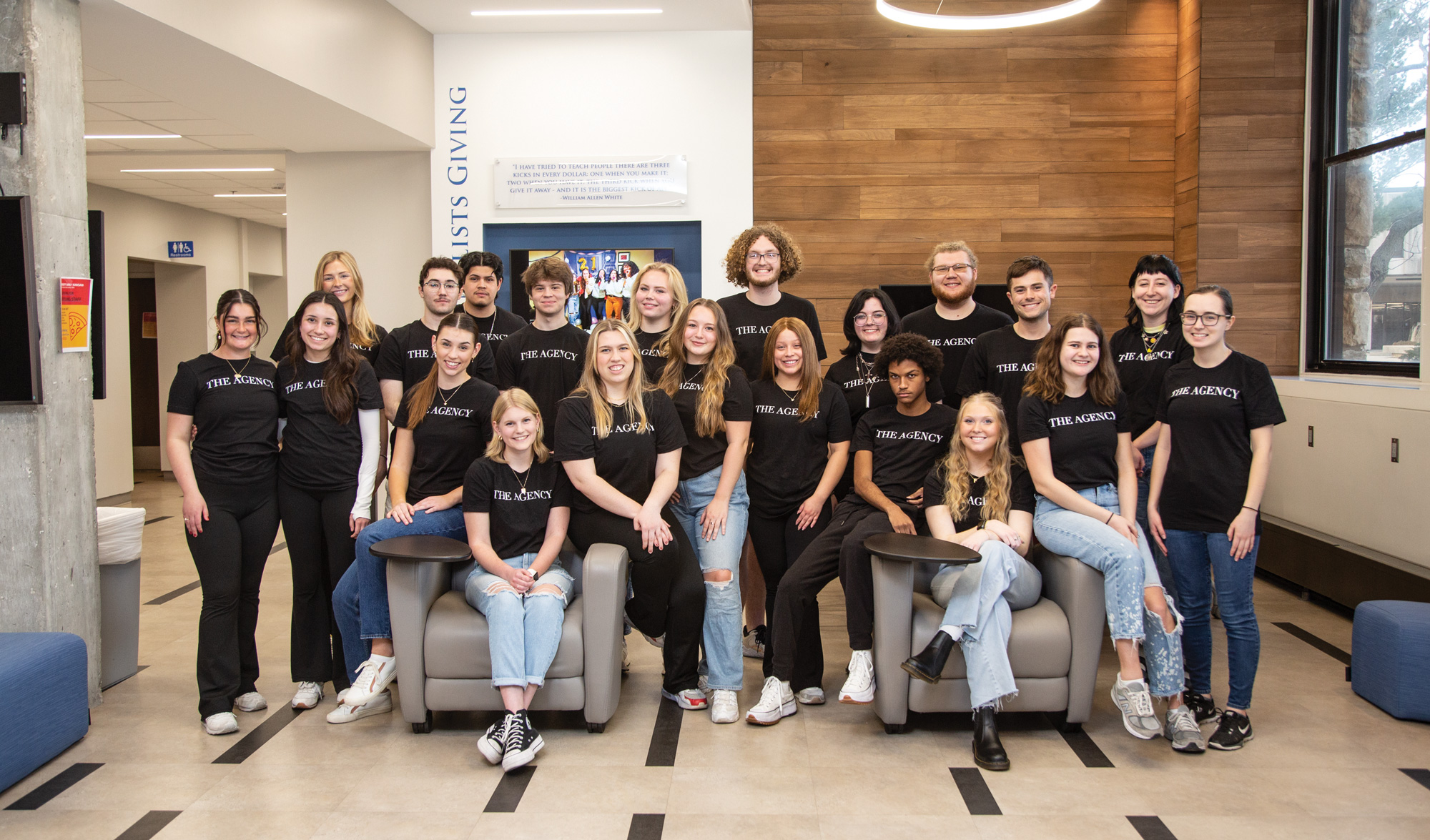
KU students who operate The Agency pose in their lobby
Media Crossroads launched in 2012 with one program: Good Morning KU. Now, some 130 students produce 10 to 15 shows a week each semester, ranging from Playmakers and other sports talk shows to ones about being Jewish or a part of the university’s Greek system, Media Crossroads Director Cal Butcher says. All are live-streamed on Media Crossroads’ Facebook page and campus television, and are available on Midco’s public access cable channel and YouTube.
“The Crossroads is where people who know how to tell stories come together to tell stories,” says Butcher, who is also a lecturer and the sports media liaison between the J-school and KU Athletics.
Students at KUJH-TV report, write, shoot and edit video, as well as work with web, graphic and live elements to produce stories for multiple formats, including daily newscasts. The station also cross-pollinates with other majors, such as atmospheric science students who want to be television meteorologists and those interested in sports management and similar careers.
There’s classwork, to be sure, but much of what students learn happens in the hours they spend behind and in front of the camera. It’s invaluable experience that routinely leads to internships—indeed, the J-school reports that 75 percent of its 2019 graduates completed at least four internships by the time they matriculated.
Lawrence’s proximity to both Kansas City and Topeka is another advantage, because students can work for broadcast stations while still attending college, says Melissa Greene-Blye, an assistant professor and director of KUJH-TV. As a result, KU’s graduates are often sought out by an industry grappling with a shortage of talent.
“Kids can start in bigger markets than were once open to them,” Greene-Blye says, and they can get that experience even as undergraduates. “I have stations knocking on my door for our juniors.”
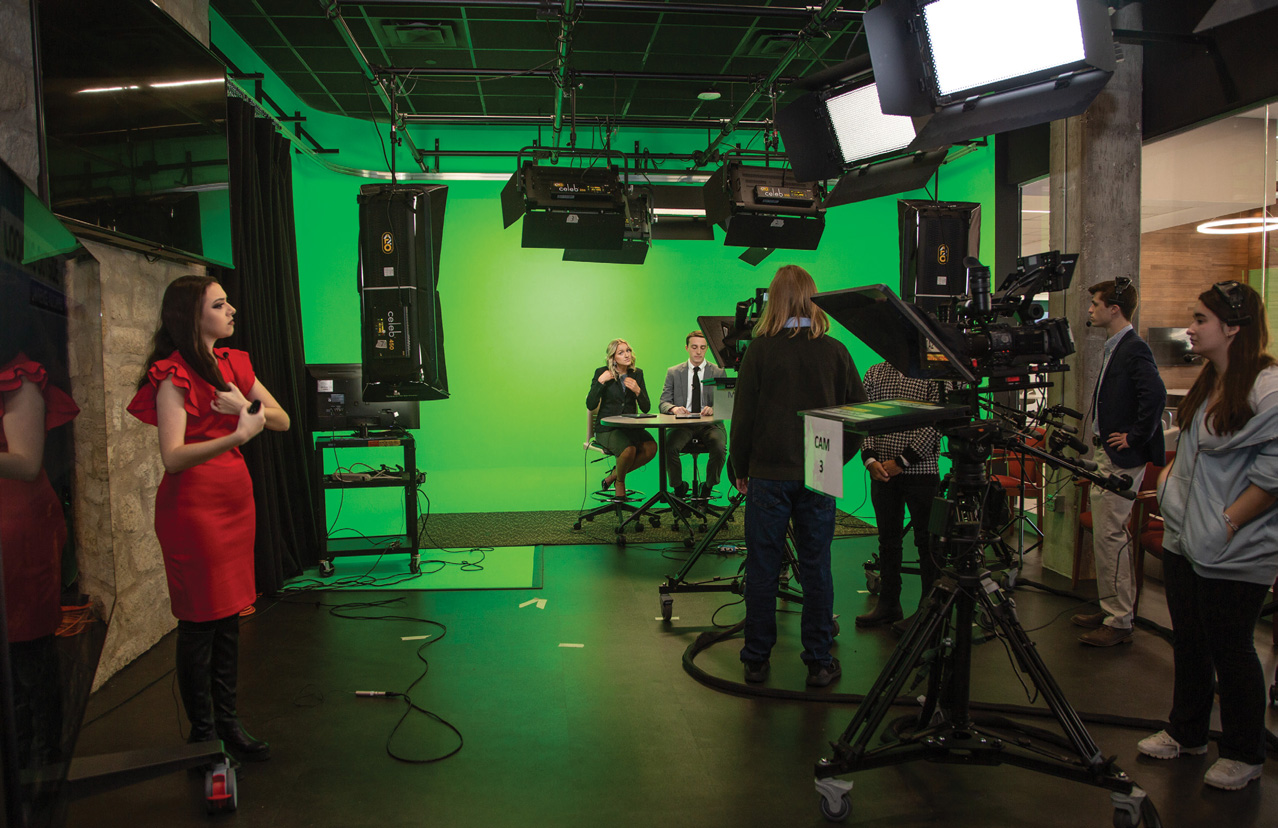
Student on air talent, camera operators, directors make last second preparations before going live
Degree Demand
Demand is also strong for the J-school’s digital marketing communications, advertising and public relations and media arts and production graduates thanks to the client interactions built into the programs.
“When we talk about our students, everybody says, ‘Let me know when they’re graduating. I need people right now, and I can’t hire people who do things like this,’ ” Brill says.
Students in the digital marketing communications, advertising and public relations concentration typically aspire to careers in advertising, marketing, public relations, social media, promotions, sales, media management and related professions. Before they get to that, though, many work for The Agency and Steam Whistle Creative.
The Agency is a student-run strategic brand and marketing communications agency, while Steam Whistle is what Director Janet Rose calls its “slightly edgier creative hothouse.” Since opening in 2014, students have developed concept, messaging and brand strategies, produced content, provided audience insights and offered related services to clients like McGrew Real Estate, Tomboy Design Studio and several colleges and schools within KU.
“The Agency and Steam Whistle Creative were really created to work with real clients with real problems,” says Rose, who is also a Professor of the Practice. “This is not a club. This is not something you show up at now and then. The people who get involved end up committing a lot of time and work to them.”
The goal: equip students to succeed at agencies big and small, as well as with media organizations, consultancies, publishing, tech companies and other employers right out of the gate.
“We’re trying to help students understand the professional world and navigate those huge curves to become sophisticated, polished professionals,” Rose says.
Professional Faculty
To do that, KU relies on faculty and lecturers whose professional credentials run as deep as their academic and research ones. Finneman is a longtime journalist and oft-published journalism historian; Rose honed her skills at agencies including McCann-Erickson and Saatchi and Saatchi X; and Greene-Blye spent 20 years as a television reporter and anchor. All three hold PhDs, as do many other faculty. The roster also includes newspaper and magazine reporters and editors; sports writers; photojournalists; documentary filmmakers; digital media and creative specialists; corporate public relations, strategic communications and market strategy professionals; and entrepreneurs.
That combined experience and resulting industry networks keep programs fresh, particularly given the interactive nature of media. Visual elements are crucial to all communication formats, and learning to craft them is at the heart of the media arts and production concentration. Audio and video production, content creation, digital media tools like augmented and visual reality, and motion graphics software, project management and gamification are among the advanced electives that give students the foundation to become copywriters and content creators, and produce and direct podcasts, audio, creative video, websites and more. It all comes down to using technology to communicate effectively, regardless of platform.
“It’s one thing to say I can create a cool visual, but what does it communicate? How do we talk about it?” Brill asks.
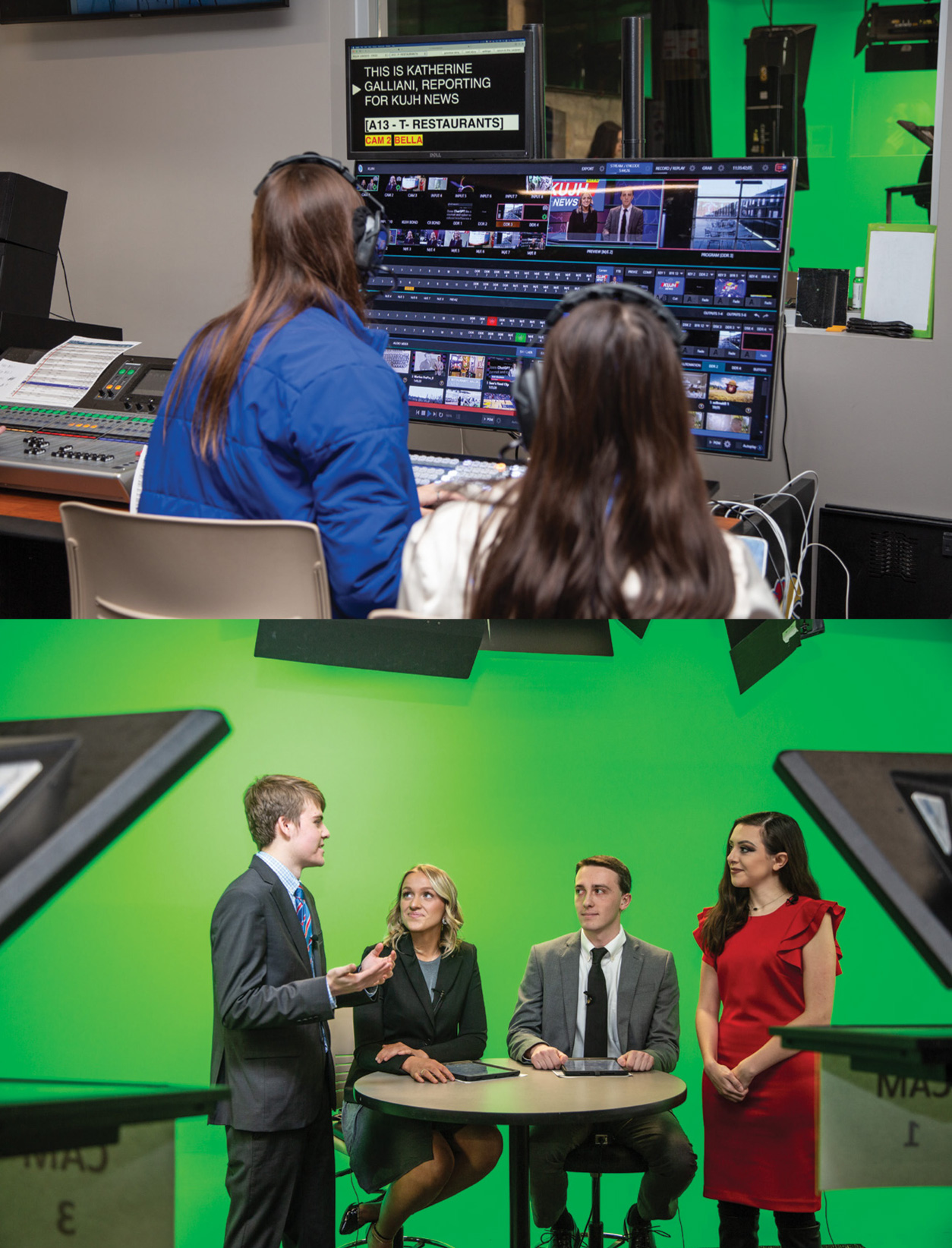
Students controlling the sound and visuals from the production room as the KUJH news team wraps up their show in front of their green screen
A New Page
Almost 85 percent of the 2021 class were employed full time in their chosen field within six months of graduation, the J-school says, and for a growing number of those, that means working in sports.
“When you talk about sports media, there’s this big, huge area,” Brill explains.
So big that the J-school is, this fall, adding sports media and society as a fourth concentration option. The program builds on existing relationships with KU Athletics and Rock Chalk Video, and adds more opportunities for students aspiring to follow in the footsteps of KU alums like NFL sideline reporter Laura Okmin and sports broadcaster Kevin Harlan, or pursue careers in sports photography, sports management or other areas.
It’s just the latest example of how KU’s J-school works to meet students’ needs, and it’s something William Allen White surely would have appreciated, Brill says.
In 1922, White wrote an editorial titled “To an Anxious Friend” that said, “the orderly business of life will go forward if only men can speak in whatever way given them to utter what their hearts hold—by voice, by posted card, by letter or by press.” It won him a Pulitzer Prize a year later, and Brill says that sentiment holds true today.
“The crux of it, (White) says, is that as long as people keep talking, things will work out,” Brill says. “That’s the role of journalists, public relations people, everybody … to keep the conversation going.”
“We’re constantly helping students understand that’s why we’re so important in society,” she says. “We are the storytellers.”

